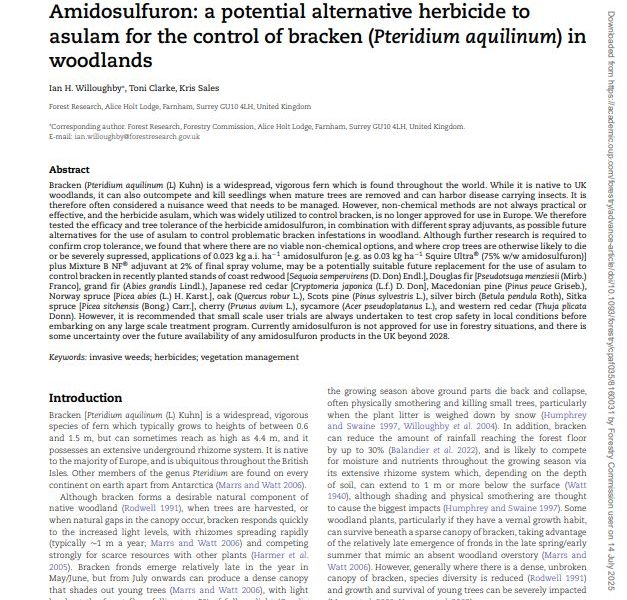We use some essential cookies to make this website work.
We’d like to set additional cookies to understand how you use forestresearch.gov.uk, remember your settings and improve our services.
We also use cookies set by other sites to help us deliver content from their services.

This research tested the efficacy and tree tolerance of the herbicide amidosulfuron, in combination with different spray adjuvants, as possible alternatives for controlling bracken infestations in woodland.
Pest and disease resources and advice from Forest Research
A selection of posters that can be downloaded as PDFs and then printed at a size to suit (up to A0 size). These were mostly produced for the 2012 APF show and have been popular as posters to display in offices or places of work. Each poster shows a selection...
Sources of information about plant health regulations applying to the import and export of plants, wood and related materials now that the UK has left the European Union
Overview of common pests and pathogens of horse chestnut.
This report reviews and summarises some of the key evidence from around the world on values associated with ash trees, and the management decisions about both ash dieback and emerald ash borer. The evidence on values focuses on historical, social and cultural values while the parts on management decisions looks...
How will the changing environment impact bark-boring insects? Climate change projections indicate more frequent extreme weather events, such as storms, heatwaves, droughts, and floods. One of the likely consequences of this will be an abundance of stressed trees with weakened defences against pests, creating favourable conditions for some species of...
Overview Resilience to climate change, the threat of pests and diseases, tackling the biodiversity crisis, and the implications of these issues for the future of the tree and woodland sector are necessarily being foregrounded in management discussions. Sycamore is a naturalised, fast-growing, and adaptable species with increasing evidence to support...
Ash dieback is a disease of ash trees caused by a fungus called Chalara fraxinea. The disease causes leaf loss and crown dieback in affected trees and it may lead to tree death. This Pest Alert provides information on distribution, symptoms, how the disease spreads and what you can do...
This project evaluates the potential use of detection dogs to support spruce movement inspections within demarcated areas in England, helping to improve the efficiency and effectiveness of efforts to control Ips typographus outbreaks.
These essential cookies do things like remember your progress through a form. They always need to be on.
We use Google Analytics to measure how you use the website so we can improve it based on user needs. Google Analytics sets cookies that store anonymised information about: how you got to the site the pages you visit on forestresearch.gov.uk and how long you spend on each page what you click on while you're visiting the site
Some forestresearch.gov.uk pages may contain content from other sites, like YouTube or Flickr, which may set their own cookies. These sites are sometimes called ‘third party’ services. This tells us how many people are seeing the content and whether it’s useful.